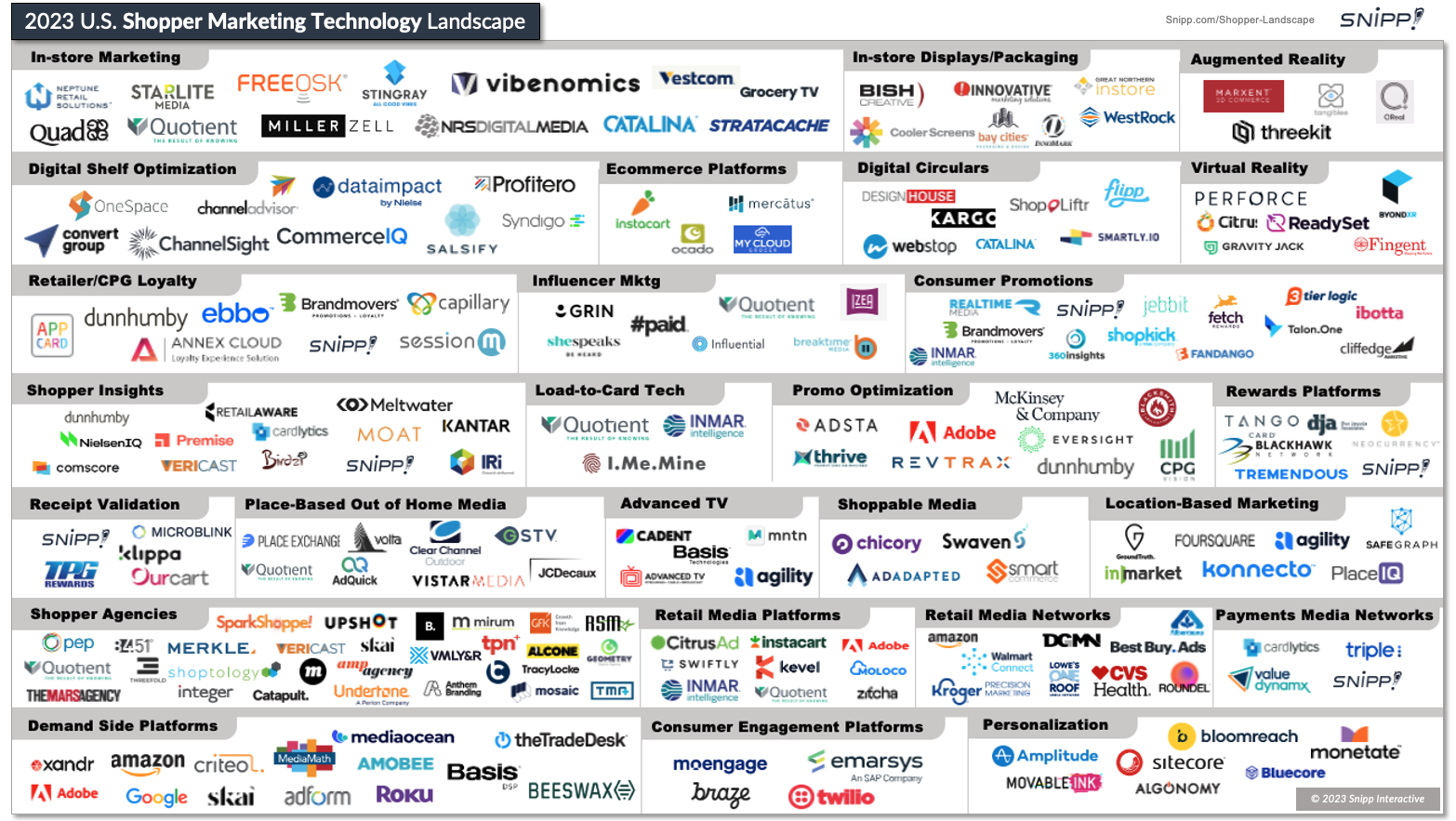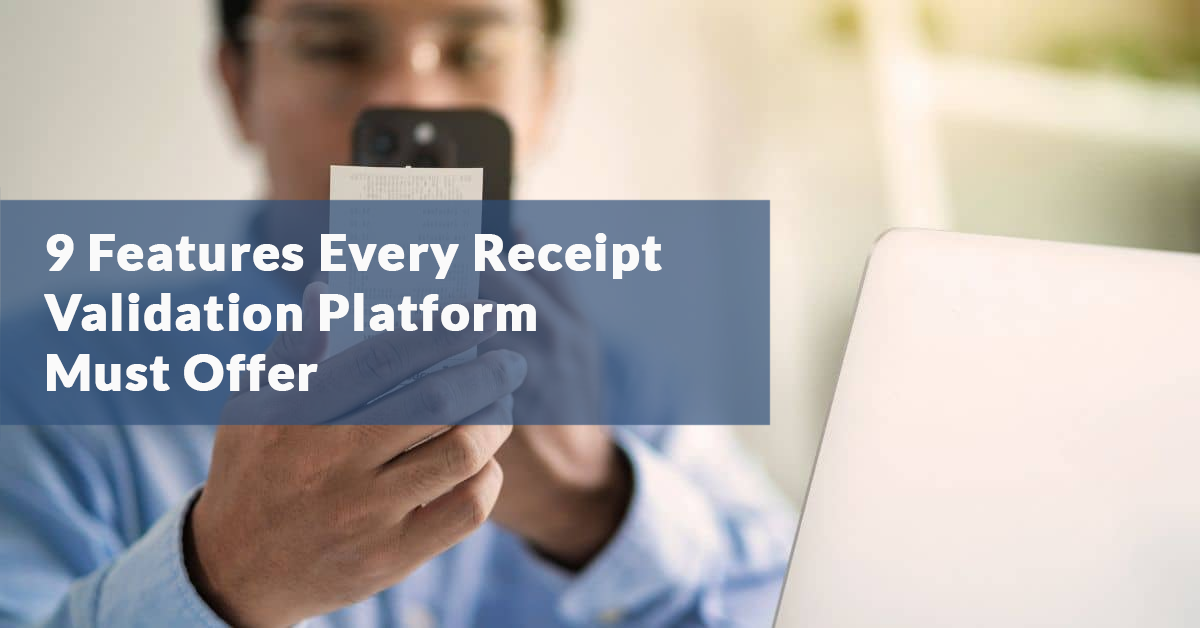In 1929 a Kroger store manager living in southern Illinois named Michael Cullen envisioned a fresh take on grocery retailing when he declared “What would happen if we turned the shop around and let people collect all the items they wanted themselves?”
After a letter to his boss outlining his self-service scheme went unanswered, he moved to Long Island NY and opened his own store he named King Kullen in Queens New York. Most people thought he was crazy - at the time, shopping entailed a shopkeeper who would fetch items from a shelf behind a counter as you waited. Cullen’s vision of letting shoppers choose products for themselves from large footprint, high volume, low margin stores launched the first modern supermarket: separate departments, self-service, discount pricing, chain marketing and volume dealing - arguably the very notion of “shopper marketing” was born.
Looking at the just-released Shopper Marketing Technology Landscape for 2023, it’s clear that Shopper Marketing is more than end caps, signage and coupons. It extends from In-store displays, digital circulars and consumer promotions to augmented and virtual reality (AR and VR), Advanced TV and Retail Media Networks, and many more highly specialized channels and technologies. Significant industry innovation is touching both traditional instore marketers and digital specialists in equal doses. Let’s jump in and examine a few examples of the shopper marketing shifts that brands, retailers and agencies will need to consider in their shopper marketing strategies.
1) Retail Media Networks - More Retailers Become Media Publishers
Retailers like Amazon, Walmart, Target and Kroger have been creating advertising opportunities for their brand partners via their owned retail media platforms for several years now. What’s new however is smaller retailers are realizing they too can have shopper audiences that they can monetize and allow their vendor partners to market to their high-intent consumers. Sponsored searches, product ads, on and offs-site banner ads and dedicated brand pages which were once reserved for larger retailers have now become available thanks to API-based integrations from tech companies like Kevel, CitrusAd and Adobe. In many cases these ad marketplaces are self-serve, meaning brands can log in and purchase ad inventory directly from their retailer partners. Many ad experts including GroupM predict that Retail Media ad revenues will top $100 billion by the end of 2022, beating out ad revenue generated from YouTube and Netflix. This new-found revenue stream has been a boon as margin pressure continues to force retailers big and small to look for sources of alternative income.
2) Advanced TV - TV Actually Gets Smart
Advancements in TV-based targeting have created major shifts in how media is placed. Rather than reaching consumers based on “what they watch” advertisers can now select the specific households they want to see their ads. This audience selection can be based on geography – down to the household level – demographics or viewing habits and interests. Data is collected directly from viewed devices, visited websites and cross-screen behavior collected by marketer and is then combined with anonymized purchase data to build profiles. In some cases, campaign data is monitored in real-time and connected back to actual in-store sales. Need to reach organic snack buyers living in Chicago who enjoy home improvement and shop at Walgreens? Check! This granularity in TV targeting and measurement delivers a more efficient use of advertiser’s media dollars since advertisers can pinpoint households and deliver ads to consumers who reside closer to where their products are sold and be more aligned with closely monitored purchase behaviors. The Advanced TV vendors, like the ones included on the Shopper Marketing Technology Landscape, have been experiencing rapid growth with CPG brands, often working with their retail partners to create co-branded ads that feature product, price, and retailer brands.
3) Instore Marketing - Store Signage Goes Digital
Reaching shoppers when entering a store with a brand’s message is a stalwart and highly effective tactic. Today, the hand painted window signs from days of yore have been replaced by gleaming, large format in-store digital signage that is dynamic and measurable based on actual in-store sales. Pittsburg based Starlite Media has demonstrated that their displays located at store entrances drove item sales lift for a shampoo brand of 44.9% over an eight-week campaign. The displays prominently featured which aisle the shampoo was available in each store further enabling consideration and at-shelf conversion.
4) Digital Circulars - Retailer Circulars Get Personal
As Target and other major retailers have begun to eliminate their distribution of weekly paper-based circulars, innovation has stepped in to fill the void, delivering personalized on-sale items to shoppers via digital channels. Florida based Catalina Marketing has worked with retailers like New England based Stop and Shop to deliver targeted mobile and in-app ads to their shoppers featuring the top weekly circular deals based on the individual shopper’s past purchases. Each shopper receives a unique set of ads matching what they recently bought and what’s on sale. They can save these personalized offers in their mobile wallets as an easy reminder for when they are ready to purchase. According to Catalina Marketing, on average, participating retailers have seen return on ad spend surpassing $25.
5) Virtual Reality - Cheetos in the Metaverse?
Today, Cullen’s goal of empowering shoppers to drive sales remains, but I’ll bet he would have never imagined engaging his NY suburbanite customers in a virtual world called the metaverse. CPG trailblazers are finding ways to stand out and get noticed and VR is one of many examples of the new face of shopper marketing. For example, Gucci recently released a limited edition virtual handbag sold on Roblox which created enough hype that someone paid $4100, around $800 more than the cost of the actual physical world Gucci bag. Closer to earthly pursuits, PepsiCo also recently launched Cheetos Digital Neighborhood inside VR Platform Meta Horizon where consumers can vote to bring their favorite no-longer-available flavors like Cheetos Flamin’ Hot Pepper Puffs back to supermarket shelves for a limited time.
6) Personalization – AI Drives More Relevant Ecommerce Experiences
Just like in-store experiences can be a huge differentiator for retailers, forging a personal relationship online has become a shopper expectation. McKinsey & Co data shows that 71% of customers expect personalization and 76% will switch if they don’t like their experience. AI-driven technology is helping improve ecommerce experiences for shoppers by personalizing their search results and site navigation to deliver more relevant product recommendations, tailored messaging, and targeted promotions. Tech company Bloomreach cited a +25% increase in customer basket-building speed after implementing their solution at Albertsons, also increasing conversion rates and basket sizes, meanwhile lowering bounce rates and with busy and often fickle online shoppers.
7) Financial Media Networks – Cash Back Bank Rewards at the Item Level
Banks and Credit Card companies offering card-linked deals to their customers is nothing new, however these offers have been restricted to store discounts and not deals on individual items. We’ve all been pitched $5 off $50 purchase from the Gap, or Omaha Steaks from Visa and MasterCard. Consumers also want to save on more every-day-spend items from brands sold at health and beauty and grocery retailers, but the technology hasn’t been there to measure item-level sales. New technologies from Financial Media Networks are enabling major CPG brands to fund discounts to consumers at the brand and item-level. Coming soon from the major credit card issuers, shoppers will be seeing discounts on cosmetics, beauty supplies and food items from national brands available at nearby retailers – personalized and easily redeemed using their existing credit cards.
The Future of Shopper Marketing
So, what's in store for the future of shopper marketing? Will we all be strapped to VR headsets browsing for high end handbags in the Metaverse? Will we all have individualized digital shopping circulars guiding us through both the aisles and towards the highest discount opportunities? If these trends are any indication, as marketers we can feel assured that technology will help us shape a closer connection with consumers, wherever they shop. We can also be more relevant and precise with our messaging, more efficient and confident in our advertising investments, and work more closely with our partners be they retailer, brand, agency, or solution provider. Cullen’s original idea of “Turning the shop around” remains. This time it’s the shopper marketers who get to roam the technology aisles with more choices than ever before.







